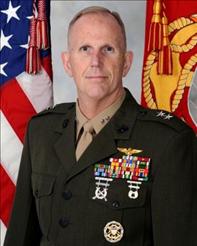08/14/2011 by Vince Martinez
For years, the amphibious arm of the Navy has struggled to gain the notoriety, the advocates and the budget that the carrier side of the Navy has been able to garner. Despite this, and through the operational ingenuity of the Sailors and Marines who serve in and around the amphibious fleet, amphibious forces have been present in nearly every hotspot of the world since World War II.
The fact of the matter is that is has been the ability for the Naval Services to not only provide presence through a fleet of naval vessels parked off the coast of troubled lands, but also the Marines who have disembarked in order to extend the long-arm of diplomacy. Whether it has been in support of humanitarian and disaster relief operations, or through full blown combat operations involving every aspect of the Marine Air Ground Task Force (MAGTF), the amphibious force has demonstrated its strategic importance many times over the years—despite many of the critics who choose to ignore that fact.
The Navy has benefited from a the multi-faceted engagement posture of an embarked amphibious force, and the Marines have helped provide the strategic, operational and tactical flexibility that is inherent in the Navy/Marine Corps team.
As everyone knows, the budget will be the primary area of concern for many of our leaders during the coming years. It will be extremely critical for all concerned to be as knowledgeable and judicious about realizing cost savings as they can be while maintaining core capabilities necessary to the nation in a challenging era.
The warfighters will still be expected to provide the operational security they are tasked to preserve, and the industry that supports them also has to be able to survive the expected downturn in the industrial complex. It will be about core capabilities, intelligently funded and supported. It will be about smart investments, decisions; not simply taking a meat cleaver to military spending.
This vast array of challenges in the 21st century will demand new and innovative ways to approach amphibious shipping requirements, and a team-based approach for exactly how to do that has to be the priority for each element of the decision-making, operational and acquisitions spectrum.
To enable such a requirement, the US Navy has initiated an unprecedented effort to shape an amphibious ship enterprise. The sponsor of this effort for the OPNAV staff has initiated a dialogue across “party” lines. OPNAV is engaging the requirements generators, the planning, programming, budgeting and execution element, and the acquisitions professionals to define a process for alignment of amphibious enterprise efforts across all the decision support elements.
Such an effort will be important to prepare for the coming budget fights and to ensure that core capabilities remain for the Nation. With stakes that loom extremely high—from inter-service competition for resources, competing requirements within the Navy and the Marine Corps, as well as accounting for the differences in service-level doctrinal perspectives, timing for this type of approach is long overdue.
Add to that the concerns of an industrial base that has to monitor continually where they put their own investment dollars in order to ensure the technological and production edge is maintained, it is now more critical than ever that the amphibious enterprise takes a hard look at all aspects of the overall effort.
Through the initiation of a Navy/Marine Air Ground Task Force (MAGTF) Ship Integration Center (N/MSIC), the Director for Expeditionary Warfare Division for the OPNAV Staff—Major General Timothy Hanifen–has embarked on the development and execution of an innovative approach. This approach not only addresses the programmatic issues of defending the budget for the amphibious shipping enterprise, but also for gathering and assessing issues across requirements, acquisitions and budget.

This approach is seeking to meet the following objectives:
- To most efficiently manage the amphibious shipping enterprise across the enterprise,
- To ensure a holistic approach across all the decision support elements that ensures a well thought out strategy for the overall enterprise, and
- To gather and assess a holistic, validated and verified set of requirements–across the entire amphibious force–in order to ensure they are adequately balanced against the realities of budget and acquisition process that has to deal with the looming programmatic and budget fiscal constraints, as well as other service level priorities.
Some might say that the lofty goal for Major General Hanifen’s N/MSIC construct will prove unattainable. But in a time of great challenge for the Department of Defense and for the services as a whole, it is this type of innovative thinking and leadership that will allow for the Naval services to ensure they maintain their operational advantage through a well defined and informed enterprise level posture—even in times that are defined by fiscal constraint.
Is it worth investing in single digit millions to ensure better-informed billion dollar decisions? Only time will tell.
But one thing is for is for sure, the Navy leadership is not waiting on the results of a study or for congress to tell them to do it—they are leading this from the front.
This type of leadership is what is expected of our Generalship and Admiralty, and those who are smart enough to know how important this can be for posturing the amphibious forces for success in the coming years should also look for ways to make this work.
The operational forces engaged around the world deserve this sort of enterprise level alignment from the supporting establishment.
Luckily, many of the senior leaders in the Navy/Marine Corps team already know this, and are moving smartly toward ensuring this isn’t a just a matter for discussion and deliberation, but rather, for bold and decisive action.


